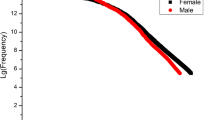Abstract
The notion of grammatical gender is defined and criteria for assigning nouns to genders are discussed, in particular semantic and formal criteria. Data from child language acquisition show that both semantic and formal criteria can be the basis of children's overgeneralizations, although the question of to what extent more opaque semantic or formal gender assignment criteria are available to children remains to be ascertained.
Similar content being viewed by others
REFERENCES
Comrie, B., & Polinsky, M. (1999). Gender in a historical perspective: radial categories meet language change. In C. F. Justus & E. C. Polomé (Eds.), Language change and typological variation. Washington, DC: Institute for the Study of Man. In press.
Comrie, B., Stone, G., and Polinsky, M. (1996). The Russian language in the twentieth century. Oxford: Oxford University Press.
Corbett, G. (1986). Gender in German: A bibliography. Linguistische Berichte, 103, 280-286.
Corbett, G. (1991). Gender. Cambridge: Cambridge University Press.
Dixon, R. M. W. (1972). The Dyirbal language of northern Queensland. Cambridge: Cambridge University Press.
Gvozdev, A. N. (1949). Formirovanie u rebenka grammatičeskogo stroja russkogo jazyka [Development of the grammatical structure of Russian in the child], 1. Moscow: Akademija pedagogičeskix nauk.
Idiata, D. F. (1998). Quelques aspects de l'acquisition de la langue isangu par les enfants [Some aspects of the acquisition of the Isangu language by children]. Doctoral dissertation. Université Lumière Lyon 2. Munich: Lincom Europa. In Press.
Lakoff, G. (1990). Women, fire, and dangerous things. Chicago: University of Chicago Press.
Matthews, P. (1997). The concise Oxford dictionary of linguistics. Oxford: Oxford University Press.
Rajabov, R. (1999). The class category in Tsez. In Howard I. Aronson (ed.), NSL-9. Chicago: Chicago Linguistic Society. In press.
Zubin, D. A., & Köpcke, K.-M. (1981). Gender: a less than arbitrary grammatical category. In Roberta A. Hendrick, Carrie S. Masek, and Mary Frances Miller (eds.), Papers from the Seventeenth Regional Meeting Chicago Linguistic Society, 439-449. Chicago: Chicago Linguistic Society.
Author information
Authors and Affiliations
Corresponding author
Rights and permissions
About this article
Cite this article
Comrie, B. Grammatical Gender Systems: A Linguist's Assessment. J Psycholinguist Res 28, 457–466 (1999). https://doi.org/10.1023/A:1023212225540
Issue Date:
DOI: https://doi.org/10.1023/A:1023212225540




